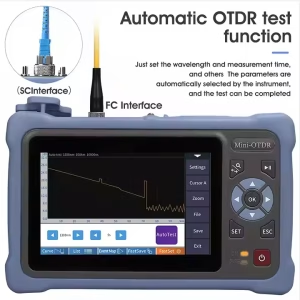
Understanding OTDR: The Essential Tool for Fiber Optic Testing
Fiber optic networks demand reliable performance. Whether installing new fiber or troubleshooting existing networks, technicians need the right tools. An OTDR (Optical Time Domain Reflectometer) stands out as the most critical instrument for maintaining fiber optic systems.
This advanced technology helps engineers optimize fiber networks with precision. Let’s explore how OTDRs work and why they’re indispensable for fiber testing.
What is an OTDR?
An Optical Time Domain Reflectometer (OTDR) tests and characterizes optical fibers. The device sends light pulses into a fiber optic cable and measures their return time.
By analyzing reflected light, the OTDR:
- Detects attenuation, splices, and connectors
- Locates faults along the cable
- Provides cable condition details
Technicians use OTDRs during installation, maintenance, and troubleshooting to:
- Ensure signal integrity
- Measure distances between components
- Identify problems before they affect performance
How Does an OTDR Work?
An OTDR transmits short light pulses through a fiber optic cable. These pulses reflect back at connection points, bends, or breaks. The device measures return time to calculate fault distances.
The OTDR creates a trace graph showing:
- Signal loss: Light intensity reduction along the fiber
- Splice losses: Signal reduction at connection points
- Reflections: Caused by connectors or faults
- Breaks: Complete signal reflections indicating cable damage
This visual map helps technicians pinpoint issues quickly.
Key Features
- High Resolution: Detects microscopic fiber imperfections
- Long Range: Tests fibers up to 80km
- Autofocus: Automatically adjusts to fiber conditions
- Portability: Lightweight designs for field work
- Multi-Wavelength: Tests 1310nm, 1550nm, and other fibers
Applications
Installation: Verifies proper cable laying and detects defects
Maintenance: Identifies fiber degradation before failures occur
Troubleshooting: Locates signal loss sources and outages
Characterization: Measures fiber quality for high-bandwidth traffic
Benefits
- Precise fault location saves repair time
- Cost-effective by preventing unnecessary replacements
- Preventive maintenance avoids network downtime
- Performance optimization ensures reliable signals
Choosing an OTDR
Consider these factors:
- Fiber type compatibility (single/multi-mode)
- Wavelength support for your network
- Testing range matching your cable lengths
- User-friendly interface for efficient operation
- Rugged design for field conditions
Conclusion
Every fiber optic technician needs an OTDR. This powerful tool saves time, reduces costs, and maintains network reliability. Whether installing new cables or maintaining existing ones, an OTDR delivers the critical insights you need for optimal fiber performance.
